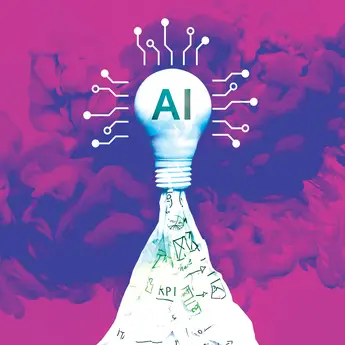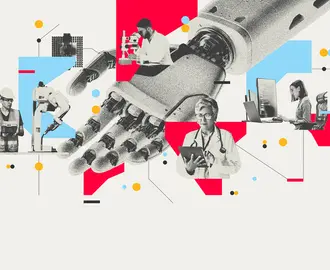Credit: Mimi Phan / vs148 / Shutterstock
The impact of generative AI as a general-purpose technology
The steam engine, the internal combustion engine, electrification, and computers are all considered “general-purpose technologies” — new tools that are powerful enough to accelerate overall economic growth and transform economies and societies. According to many experts, generative artificial intelligence will be the next invention to join that category.
In a recent report about the economic impact of generative AI, Google visiting fellow and MIT Sloan principal research scientist Andrew McAfee makes the case that generative AI is not only a game-changing general-purpose technology but could also spur change far more quickly than preceding innovations due to its accessibility and ease of diffusion.
General-purpose technologies
General-purpose technologies possess three key characteristics that ensure that they will have a large and positive economy-wide impact on productivity and growth. Though generative AI is still relatively new, McAfee writes that generative AI has these characteristics:
Rapid improvement. Though it became mainstream only a few years ago, generative AI has quickly improved at generating relevant and accurate content in response to user prompts. McAfee notes that OpenAI’s GPT 3.5 system, released in late 2022, performed better on the U.S. bar exam than about 10% of the human test-takers. GPT 4, released in March 2023, performed better than 90% of those taking the bar exam.
Generative AI’s “context window” — how much information it can accept from users — has also grown quickly. In 2020, state-of-the-art generative AI systems could accommodate approximately seven and a half pages of text; in late 2023, that window was 40 times larger, up to nearly 300 pages of text.
Pervasiveness. General-purpose technologies need to be widely implemented — which is already true of generative AI. In a 2023 survey of 14,000 users across a range of industries and professions, 28% of respondents said that they are using generative AI at work — over half without formal approval from their employer — and another 32% expected to use the technology at work soon. Another 2023 study found that about 80% of U.S. workers could have at least 10% of their work tasks affected by the introduction of generative AI. About 19% of workers could see at least half of their work tasks affected by the technology, the study found.

AI Executive Academy
In person at MIT Sloan
Register Now
Complementary innovations. While generative AI can quickly generate text, pictures, and sound from prompts, there is plenty of work being done to push it beyond those boundaries. Generative AI is being used not just to improve individual tasks but to streamline entire processes, McAfee writes, and researchers are confident that innovations making use of generative AI’s capabilities will advance science and engineering.
“Because of generative AI’s rapid improvement, pervasiveness, and clear potential for complementary innovation, we are confident that it merits the label of ‘general-purpose technology,’” McAfee writes.
Generative AI’s accelerated pace of change
Past general-purpose technologies took time to have a transformational impact, mainly because they required a new infrastructure. For example, electrical transmission networks needed to be in place to take advantage of electrification. In addition, most advantages associated with past technologies materialized only after users had had the chance to ideate and implement complementary innovations, McAfee writes.
Related Articles
In contrast, generative AI’s effects will manifest more quickly because much of the required infrastructure — internet-connected devices — is immediately available and already widely used. Generative AI doesn’t require mastery of computer skills or proficiency in a programming language, as people use natural human language to interact with the system.
In terms of being an engine for economic growth, experts predict serious gains. Goldman Sachs estimates that generative AI will be responsible for a 0.4 percentage point increase in GDP growth in the United States over the next decade. There are also ramifications beyond growth statistics. By automating mundane tasks, generative AI will allow people to do more meaningful work, whether that’s enabling physicians to spend less time on paperwork and more time caring for patients or helping professionals dig into upskilling and training.
However, there are also concerns that people across industries will need to learn new skills and rethink their career paths. There are risks associated with disinformation as well.
Despite these drawbacks, McAfee writes that generative AI has the potential to fuel wide-scale economic growth.
“Generative AI is already improving the productivity and quality of many tasks, and the technology is beginning to be used to redesign multi-step, multi-group processes, making them faster and less labor-intensive,” McAfee writes. “This technology’s deepest impact on the world of work will come as it’s used to reimagine entire organizations. This deep reimagination will be a decentralized and distributed phenomenon, carried out by innovators and entrepreneurs throughout the economy.”
Read the report: “The Economic Impact of Generative AI”




